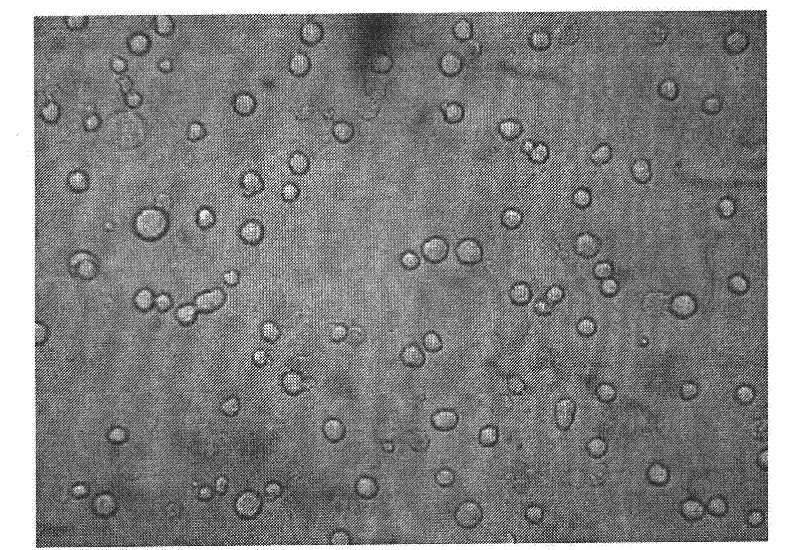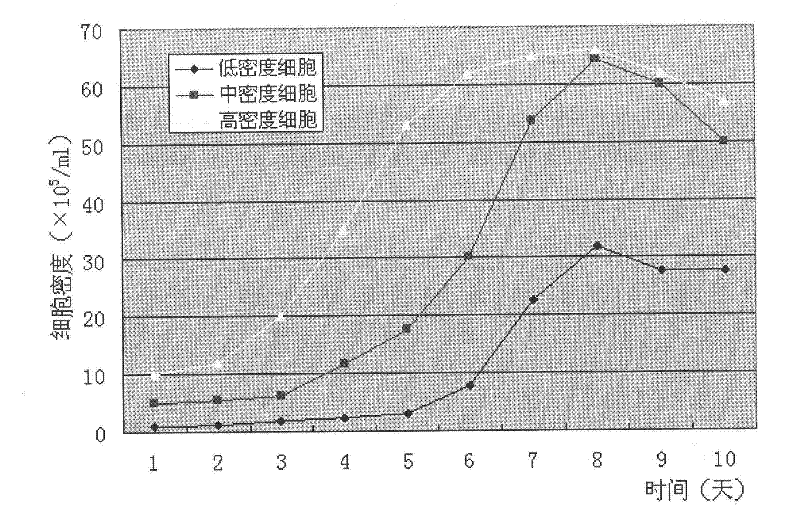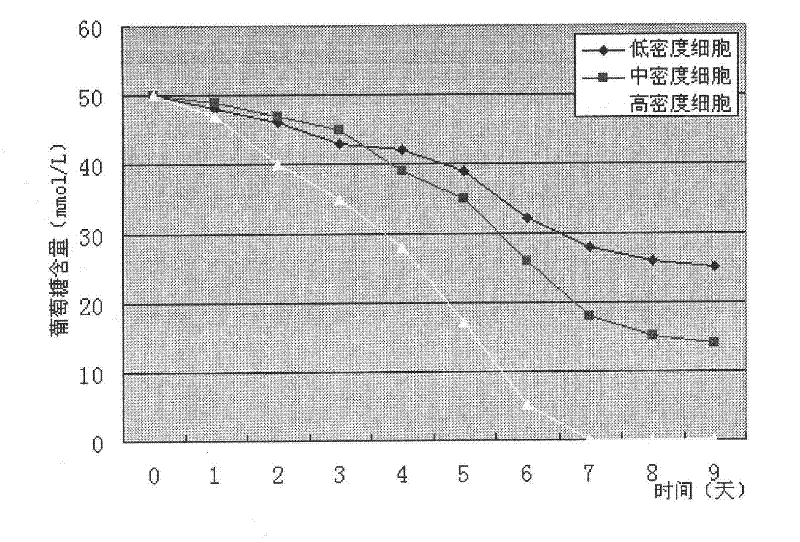Method for culturing insect cells and preparing HPV (human papillomavirus) 16/18 L1 proteins by applying biological reactor
An HPV16L1 and bioreactor technology, which is applied in the field of preparing exogenous proteins such as human papillomavirus 16 and 18 L1 proteins, can solve problems such as cell damage and death, and achieve the effects of optimizing conditions and methods and increasing the scale of culture.
- Summary
- Abstract
- Description
- Claims
- Application Information
AI Technical Summary
Problems solved by technology
Method used
Image
Examples
Embodiment 1
[0031] Embodiment 1. utilizes the condition of bioreactor to cultivate Sf-9 cell
[0032] The frozen insect cell Sf-9 (Invitrogen Company) was taken out from liquid nitrogen, quickly placed in a 27°C water bath for thawing, and then centrifuged at 1000rpm for 5 minutes, and the supernatant was discarded. The cell pellet was resuspended in 0.5ml Grace growth solution (Grace (Gibco company) 4.572%, NaHCO 30.035%, hydrolyzed milk protein (Oxid company) 0.33%, yeast extract (Oxid company) 0.33%, fetal bovine serum (Hyclone company) 10%, penicillin 4U, streptomycin 10U, pH 6.5), and then transfer Transfer to a T25 culture flask containing 6ml of Grace Growth Medium and grow in an incubator at 27°C for 3 days. After the Sf-9 cells confluent into a monolayer, the culture supernatant was discarded, and 10 ml of fresh Grace growth solution was added. The adherent cells were gently blown off, then transferred to a sterile Erlenmeyer flask (sealed with a gas-permeable film), and the ...
Embodiment 2
[0035] Example 2. Determination of Proliferation of Recombinant Baculovirus
[0036] When the Sf-9 cells proliferated in the bioreactor to the end of the logarithm or the early stage of the plateau, a recombinant baculovirus carrying the HPV16 L1 gene (GeneBank accession number 1489082) was added (the baculovirus was derived from a kit from BD, USA, BD Baculo Gold TM , 560129) or the recombinant baculovirus carrying the HPV18 L1 gene (GeneBank accession number ADC35715), continue to culture for 4 days. Take 1ml of cell culture medium every 12 hours, and measure the titer of recombinant baculovirus therein. Briefly, 1ml of the infected cell culture solution was taken, centrifuged at 1000rpm for 5 minutes, and the supernatant and cell pellet were collected respectively. Use Grace diluent (Grace (Gibco company) 4.572%, NaHCO 3 0.035%, hydrolyzed milk protein (Oxid company) 0.33%, yeast extract (Oxid company) 0.33%, penicillin 4U, streptomycin 10U, pH 6.5) carry out 10-fold ...
Embodiment 3
[0038] Example 3. Determination of HPV16 / 18 L1 protein expressed by insect cells
[0039] After infection of Sf-9 cells cultured in a bioreactor with recombinant baculovirus, HPV16 / 18 L1 protein expressed by insect cells was measured every 12 hours. Briefly, the cell culture fluid was taken and the cell pellet was separated. to every 10 6 100 μl of lysate (50 mmol / L Tris-HCl (pH 8.0); 15 mmol / L NaCl; 0.1 mmol / L PMSF; 0.1% NP40; 5 mmol / L EDTA) was added to each cell and ultrasonically disrupted to lyse Sf-9 cells. After lysis, centrifuge at 10,000 g for 15 min at 4°C to remove cell debris. 100 μl of supernatant was added to a 96-well plate coated with anti-HPV16 L1 or anti-HPV18 L1 polyclonal antibody (SANTA CRUZ BIOTECHNOLOGY Company). At the same time, a predetermined amount of purified HPV16 / 18 L1 protein was used as a control to prepare a standard curve for quantitative protein. Plates were then incubated for 1 hour at 37°C. After incubation, the plate was washed thr...
PUM
 Login to View More
Login to View More Abstract
Description
Claims
Application Information
 Login to View More
Login to View More - R&D
- Intellectual Property
- Life Sciences
- Materials
- Tech Scout
- Unparalleled Data Quality
- Higher Quality Content
- 60% Fewer Hallucinations
Browse by: Latest US Patents, China's latest patents, Technical Efficacy Thesaurus, Application Domain, Technology Topic, Popular Technical Reports.
© 2025 PatSnap. All rights reserved.Legal|Privacy policy|Modern Slavery Act Transparency Statement|Sitemap|About US| Contact US: help@patsnap.com



